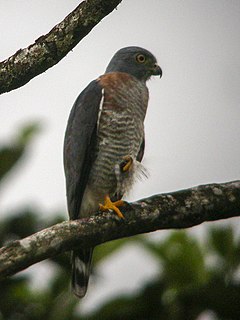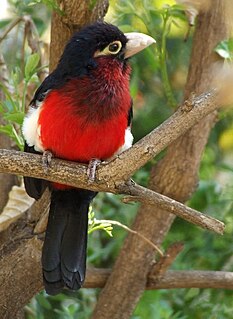Astragalus bidentatus is a species of plant in the family Fabaceae. It is found only in Ecuador in two locations in the south above the timberline in the Azuay and Cañar provinces. Its natural habitat is subtropical or tropical high-altitude grassland. No specimens have been taken since 1945 and none are contained in museums.

The double-toothed kite is a species of bird of prey in the family Accipitridae. It is found in Belize, Bolivia, Brazil, Colombia, Costa Rica, Ecuador, El Salvador, French Guiana, Guatemala, Guyana, Honduras, Mexico, Nicaragua, Panama, Peru, Suriname, Trinidad and Tobago, and Venezuela.

The double-toothed barbet is a species of bird in the family Lybiidae. It is found in Angola, Benin, Burundi, Cameroon, Central African Republic, Republic of the Congo, Democratic Republic of the Congo, Ivory Coast, Equatorial Guinea, Ethiopia, Gabon, Ghana, Guinea, Guinea-Bissau, Kenya, Liberia, Mali, Nigeria, Rwanda, Sierra Leone, South Sudan, Tanzania, Togo, and Uganda. Within Lybius bidentatus, there are two subspecies: Lybius bidentatus bidentatus and Lybius bidentatus aequatorialis.
Aphaenogaster bidentatus is a species of ant in the family Formicidae. It is endemic to the United States.
Paragigagnathus amantis is a species of mite in the family Phytoseiidae.
Paragigagnathus cataractus is a species of mite in the family Phytoseiidae.
Paragigagnathus desertorum is a species of mite in the family Phytoseiidae.
Paragigagnathus insuetus is a species of mite in the family Phytoseiidae.
Paragigagnathus molestus is a species of mite in the family Phytoseiidae.
Paragigagnathus namibiaensis is a species of mite in the family Phytoseiidae.
Paragigagnathus tamaricis is a species of mite in the family Phytoseiidae.
Dundocharax bidentatus is a species of distichodontid fish endemic to Angola, where it is found in the Lucoge River.
Chlopsis bidentatus is an eel in the family Chlopsidae. It was described by Kenneth A. Tighe and John E. McCosker in 2003. It is a deep-water, marine eel which is known from New Caledonia and Fiji, in the western central Pacific Ocean. It typically dwells at a depth range of 300–503 m. Males can reach a maximum total length of 16.7 cm.
Xenomystax bidentatus is an eel in the family Congridae. It was described by Earl Desmond Reid in 1940. It is a marine, tropical eel which is known from northern South America, in the western central Atlantic Ocean. It is known to dwell at a depth range of 494 to 604 meters.
Oxyepoecus bidentatus is a Neotropical species of ant in the genus Oxyepoecus. The species is only known from workers from Paraguay.
Phidippus bidentatus is a species of jumping spider in the family Salticidae. It is found in a range from the United States to Costa Rica.
Cryptophagus bidentatus is a species of silken fungus beetle in the family Cryptophagidae. It is found in North America.

Silvanus bidentatus, known generally as the flat bark beetle or two-toothed grain beetle, is a species of silvanid flat bark beetle in the family Silvanidae. It is found in North America, Oceania, and Europe.
Mosillus bidentatus is a species of shore flies in the family Ephydridae.
Convolvulus bidentatus is a species plant in the family Convolvulaceae. It is native to the Cape Provinces.


